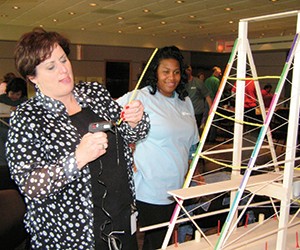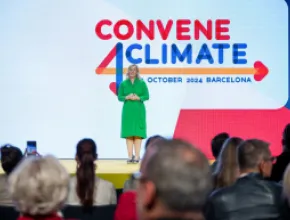The MICE industry has long talked sustainability. Some planners and sponsors have even walked sustainability with changes such as eliminating paper programs and handouts, or requiring recyclable or compostable food service implements and containers.
Now sustainability is moving to teambuilding and CSR events—“Green is a big plus for planners, for sponsors and for attendees,” says Stacey Crivello, account director for ACCESS Destination Services. “Companies are feeling the demand from their own employees to do good and to be more sustainable. Our role as planners is to align companies with something that is meaningful and inspiring. Attendees don’t want to go to a meeting and go home today. They want to be part of something bigger.”
For ACCESS client Dräger Medical, that “something bigger” was taking an entire 500-attendee national sales event to Sunshine Acres, a foster home service in Phoenix. The group transformed an empty lot into a 20,000-square-foot park in five hours, complete with trees, a lawn, an irrigation system, benches, planters and a walking path.
“Sustainability is a big plus for employees, especially for Millennials, who are poised to take over the labor market,” says Nancy Zavada, CMP, principal of MeetGreen in Portland, Ore. “They want to work for companies that care. And in this world of radical transparency, companies want to do something that is helpful to the world.”
Green Nuts and Bolts
There are two basic flavors of sustainable teambuilding and CSR. One approach is to link your green project to the destination like Dräger did. That can involve significant logistics, planning and transportation to get attendees from their meeting venue to the project site.
The advantage, Zavada says, is seeing immediate results. The disadvantage is needing a planner or a local supplier who is familiar with local needs and resources.
The other approach is to work with a group that creates portable programs. Two of her favorites are StopHungerNow.org and CleanTheWorld.org. Stop Hunger Now works with groups to create meal-packing events for later distribution. Clean the World creates personal hygiene kits using hotel amenities and similar products.
“These providers bring all the supplies, you supply the people and everybody tries to pack as many kits as they can in a fixed period,” Zavada says. “The organization takes care of all the details so the planner doesn’t have to figure out the local logistics.”
Bringing the green event to the meeting can also save time. There are no additional logistics for planner or sponsor and no time lost to transportation. Nor does the event come to a halt while attendees go off for their green activity. Holding the event on-site helps sustain and build momentum.
Cloud software provider NetSuite can work either way as long as it creates a positive impact, says Erin Dieterich, its director of corporate citizenship. She runs the company’s CSR program, NetSuite.org. Through this program the company donates software and time for training and creates volunteer programs that allow employees to give back wherever they work or meet.
“We have started adding off-site activities to our meetings and events in lieu of more traditional teambuilding activities,” Dieterich says. “Focusing on sustainability is tremendously empowering to our teams. Working together in a different environment, like cleaning up Half Moon Bay [Calif.] State Beach, not far from our headquarters, or planting trees in local parks around Manila, through our Philippines office, makes a real difference in their collaborative efforts at work. And knowing that you are making a difference is impactful on the personal level.”
On the practical side, pulling teams away from a sales meeting to plant trees can lower the overall event cost. Catering lunch in a park is typically far less expensive than lunch in a local hotel, restaurant or convention center. And sustainability brings very real rewards for the company.
“Internal surveys tell us that our employees across every [region] value environmental activities,” Dieterich says. “They want to make an impact and expect their employers to provide those opportunities. We see a direct correlation between employee retention and engagement and the environmental activities we offer.”
PageBreak
Imagine the Limits
“Some companies get sustainability and some don’t get it at all,” says Chris Hill, founder of Hands Up Incentives in the U.K. “On the client side, it comes down to philosophy. As a planner, sustainability differentiates us in a crowded marketplace. We are the people who can help a company do good while they are being good.”
Building projects are particularly good teambuilders, he says, because teamwork comes naturally. Where employees might roll their eyes at a ropes course, they are immediately engaged in building a school playground.
“People can push out of their comfort zone when they are building something,” he says. “It is extra powerful to be doing something that helps other people. It is teambuilding by stealth.”
Adding sustainability to event activities doesn’t have to add cost. Every teambuilding activity has a cost, but most companies are more concerned about the potential impact.
“Cost is not the first question I get from companies,” says Alan Ranzer, founder and managing partner of Impact 4 Good. “The first question is what can I do that is green and does it make sense for the company? You have to look at who is going to be at the event and what would hook their interest.”
Patrick Lussier, president of Outeractive Experience in Quebec, has had great success with bike building programs. Assembling bicycles to donate to charity may look complicated, but it’s easy enough for almost any corporate group from any department.
“Building bikes provides a feel-good ending to your teambuilding,” he says. “It makes your participants feel good, it is non-polluting, and it is very efficient at delivering good.”
Unless your participants are engineers, for whom bike building may not be much of a challenge. They might respond better to a more complex challenge like building race cars from recycled materials and racing them, suggests Janet Rudolph, owner and director of TeamBuilding Unlimited. Other groups might respond better to a takeoff from Project Runway, Project Recycled Runway, creating couture from newspaper, cardboard, garbage bags, scraps of cloth, duct tape and recycled accessories.
“Finding ways to use materials that others have already thrown away is fun, but it’s a concept attendees can take back to the workplace,” she says. “Our primary goal is bonding while people rethink the ordinary. Green is a no-brainer, but the top requirement for teambuilding is fun.”
Alan Muskat takes sustainable fun in a different direction. He leads groups foraging for wild foods around Asheville, N.C. He can cook a quick sampling of wild mushrooms and other edibles attendees find or they can take them to one of several local restaurants to be turned into appetizers for an event meal.
“Look for a project that plays to the strengths and skills of your attendees,” Zavada suggests. “If you’re a tech company, your greatest contribution might be a half-day hacking computer code for a school. Or it might be rebuilding a playground. Either way, the people who do it feel better, the organization has a story to tell and the world is a better place. It makes a ropes course look pretty old-fashioned.”
FRED GEBHART is a longtime contributor to Meetings Focus who has covered nearly every meetings topic.
UPCOMING FREE WEBINAR
Sustainable Meetings
Presenters: Kate Hurst & Jeff Chase
Sept. 30, 2015 | 1:00 PM EDT
www.meetingstoday.com/Webinars






